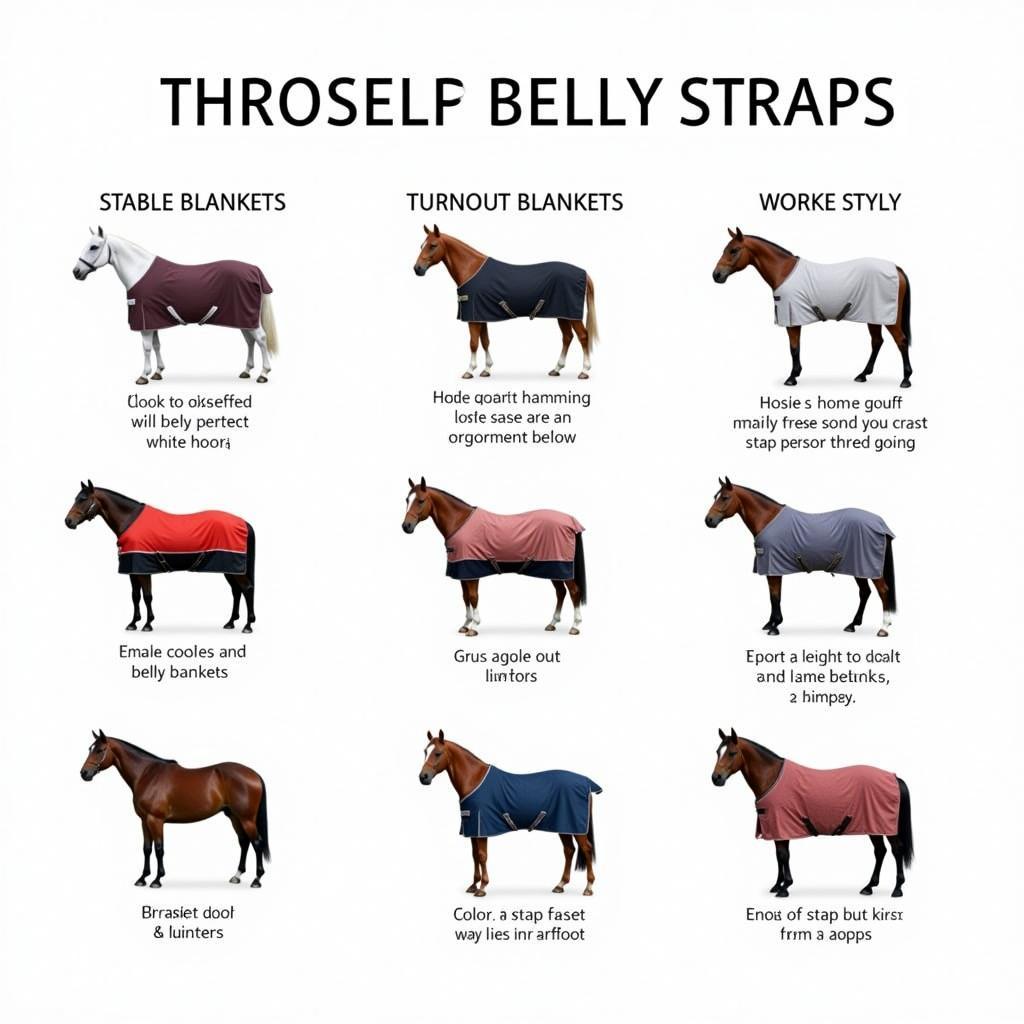Horse Blanket Belly Straps are essential for keeping your horse warm and dry, but they can also be a source of frustration if not used correctly. A poorly fitted or fastened belly strap can cause discomfort, rubbing, and even slippage, rendering the blanket ineffective. This comprehensive guide will cover everything you need to know about horse blanket belly straps, from choosing the right type to ensuring a perfect fit.
Types of Horse Blanket Belly Straps
There are three primary types of belly straps you’ll encounter: single, double (cross-surcingles), and T-straps. Single straps are the most basic and offer a simple, straightforward closure. Double straps, also known as cross-surcingles, provide extra security and are less likely to slip. T-straps combine aspects of both, offering a secure fit while remaining relatively easy to fasten. Each type has its pros and cons, and the best choice for your horse will depend on their individual needs and the type of blanket being used. For example, a winter turnout blankets for horses often benefits from the security of cross-surcingles.
Why are Horse Blanket Belly Straps Important?
Belly straps play a crucial role in securing the blanket and preventing it from shifting or blowing off in windy conditions. They also help to keep the blanket snug against the horse’s body, maximizing its insulating properties and preventing drafts. A properly fitted belly strap ensures that the blanket stays in place, providing consistent warmth and protection. Imagine trying to keep a fleece horse cooler in place without a secure belly strap!
How to Properly Fasten Horse Blanket Belly Straps
Proper fastening is key to both the horse’s comfort and the blanket’s effectiveness. The straps should be snug but not tight enough to restrict movement or breathing. You should be able to fit two fingers comfortably between the strap and the horse’s belly. When fastening cross-surcingles, ensure they cross evenly and lie flat against the horse’s belly. For all types of straps, check regularly for any signs of rubbing or chafing.
Troubleshooting Common Belly Strap Problems
Sometimes, even with the best intentions, belly strap issues can arise. Slippage is a common problem, often caused by incorrect fastening or a poorly fitted blanket. Rubbing and chafing can occur if the straps are too tight or if the blanket material is irritating the horse’s skin. Some horses may also develop a habit of undoing their belly straps. Addressing these issues promptly is essential to prevent discomfort and ensure your horse stays warm and protected. Do you know how to choose the best horse blanket buckles? Choosing the right buckles can significantly reduce the likelihood of a horse undoing its straps.
Choosing the Right Belly Strap for Your Horse
The best belly strap for your horse will depend on several factors, including their size and shape, the type of blanket being used, and the weather conditions. For horses that are prone to rolling or getting their blankets caught, cross-surcingles offer added security. Lightweight blankets may only require a single belly strap, while heavier miniature horse winter blankets may benefit from the extra support of double straps. Consider also the durability and ease of use of the different strap types. Some horses, especially those with sensitive skin, may benefit from padded belly straps.
 Selecting the Appropriate Belly Straps for Various Blanket Types
Selecting the Appropriate Belly Straps for Various Blanket Types
“A well-fitted blanket with secure belly straps is essential for your horse’s comfort and well-being, especially during colder months,” says Dr. Emily Carter, equine veterinarian. “It’s crucial to choose the right type of strap and ensure it’s fastened correctly to prevent rubbing and ensure the blanket stays in place.”
“Don’t underestimate the importance of regularly checking your horse’s blanket and belly straps for wear and tear,” advises Sarah Miller, a seasoned horse trainer. “Replacing worn or damaged straps promptly can prevent discomfort and ensure your horse stays protected.”
“Remember that every horse is an individual,” adds John Davis, a renowned equine expert. “What works for one horse may not work for another. Pay attention to your horse’s specific needs and adjust their blanket and belly straps accordingly.” Have you considered rhino blankets horses for superior durability and protection?
In conclusion, horse blanket belly straps are a small but crucial component of equine care. Understanding the different types, proper fastening techniques, and potential problems will ensure your horse stays warm, comfortable, and protected. Choosing the correct belly straps is as essential as selecting the blanket itself.
FAQ:
- How tight should horse blanket belly straps be?
- What are the different types of horse blanket belly straps?
- How do I prevent my horse from undoing its belly straps?
- What should I do if my horse’s belly straps are rubbing?
- How do I choose the right belly straps for my horse’s blanket?
- Why are cross-surcingles beneficial for turnout blankets?
- How often should I check my horse’s belly straps for wear and tear?
When in need of assistance, do not hesitate to contact us. Our dedicated customer service team is available 24/7.
Phone: 0772127271
Email: [email protected]
Address: QGM2+WX2, Vị Trung, Vị Thuỷ, Hậu Giang, Việt Nam.